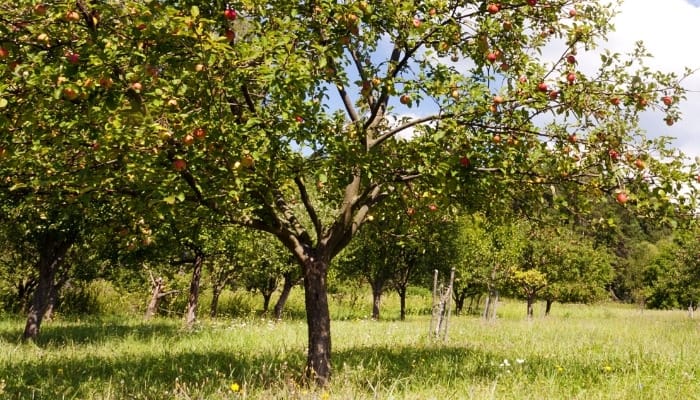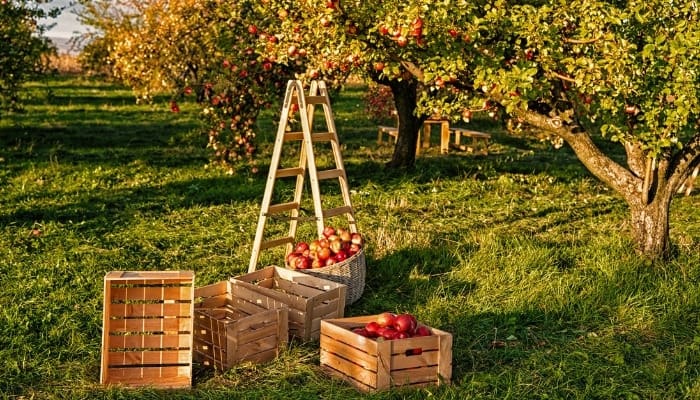It is commonly believed that planting low-growing and aggressive plants, like mint, underneath fruit trees is a suitable alternative for mulch.
However, once you get some decent life experience, you’ll realize that conventional wisdom isn’t always … wise, and when it comes to planting mint under apple trees, you need to take a step back and reconsider.
Should you plant mint under apple trees? Mint is not a good companion plant to grow under apple trees. Despite its aroma, ground-cover qualities, and ornamental values, mint’s aggressive roots spread quickly and compete with the apple tree’s feeder roots for resources and moisture near the surface of the soil.
That doesn’t mean that mint as a companion plant doesn’t have its merits, but those merits are offset by the amount of harm it can do to the soil and the apple tree.
Read more to find out why you should avoid planting mint under apple trees and what are better companions you can grow in its shade instead.
Planting Mint Under Apple Trees
Mint is an aromatic herb that acts as an excellent ground cover.
It saves you the trouble of adding mulch to keep weeds at bay and improve water retention in the soil, but all of this comes at a cost, especially when you plant it under a heavy feeder like the apple tree.
Drawbacks To Planting Mint Under Apple Trees
Before you pair plants together, you need to think of the possible drawbacks of that union.
This is especially true when one plant is small and seemingly harmless like mint while the other is a large and established fruit tree.
Here are the downsides of planting mint under apple trees.
Competing Over Resources
Even though apple trees have a complex root system that grows deep and reaches far in the soil, most of the feeder roots stay close to the surface of the soil.
Mint, on the other hand, has a far-reaching root system that develops fast and spreads horizontally, creating a thick web of roots.
All the water and fertilizer you pour into the soil will have to pass through the mint roots. What remains will trickle down to the apple tree roots.
Aggressive Growth
To say that mint is an aggressive plant is an understatement. It tends to spread quickly and take up every available inch of real estate in the garden.
Before you know it, you’ll be uprooting mint plants left and right trying to keep them limited to the confines of the dropline of the apple tree.
Hard To Get Rid Of
Mint is a stubborn plant and hard to get rid of. This is why even common weeds cannot penetrate it.
You can’t smother the mint because of all the runners that keep popping up and starting all over again. The deep roots make it hard to pull out of the soil as well.
Possible Benefits of Planting Mint Under Apple Trees
That doesn’t mean that mint is just as bad as weeds. The herb has some advantages when you grow it under apple trees.
Ground Cover
As a low-growing plant, mint has a fast growth rate that allows it to cover the ground around the base of the apple tree.
By doing so, it will stop weeds and other invasive plants in their tracks, which also eliminates many pests.
Ornamental and Practical Values
Mint is an aromatic herb that, when cut, will keep the garden smelling fresh. You can also use it to make teas and add to your food. The green leaves transform the garden and attract good bugs.
Mulch
Mint is a good replacement for mulch. It regulates the temperature of the soil and prevents invasive plants from growing near the apple tree.
Better Choices for Apple Tree Companion Plants

Apple tree companion plants, aka an apple tree guild, are a group of plants that grow well under the apple tree and help the tree grow and thrive.
These companion plants can be grouped together based on their functionality.
Plants To Suppress Weeds
Plants such as onions, leeks, and garlic do an excellent job of keeping weeds at bay. They’re also edibles, so that’s an added advantage.
You can also grow daffodils, rhubarb, white clover, and vining squashes to serve the same purpose.
Plants That Deter Pests
If you’re worried about the damage insects could do to the apple tree, consider growing nasturtiums, chives, chrysanthemums, wormwood, marigolds, and garlic.
They keep Japanese beetles, aphids, and codling moths as well as rabbits and deer away from the tree and the garden altogether.
Plants That Attract Pollinators
When attracting pollinators to the apple tree, make sure the companion plants bloom either before or after the apple tree so that the pollinators will focus on the tree.
I recommend fennel, coriander, and dill as good options.
Related Questions:
What Is an Apple Tree Guild?
An apple tree guild is a collection of companion plants that do well together and provide benefits to the apple tree.
Some plants would deter pests and pesky wildlife while others would suppress weeds and other invasive plants.
Still others would attract pollinators and good insects that protect the apple tree and feed on pests.
What Should You Not Plant Near an Apple Tree?
When choosing companion plants for your apple guild, make sure the plants will not compete with the tree over resources, become invasive themselves, or might distract pollinators by blooming around the same time as the apple tree.
Conclusion
Although mint as an aromatic herb has many benefits in the garden, it has no place growing under apple trees.
The aggressive plant is a heavy feeder with a robust root system that spreads near the surface and competes with the apple tree for resources.
Mint is also hard to get rid of and tends to spread and become invasive.

